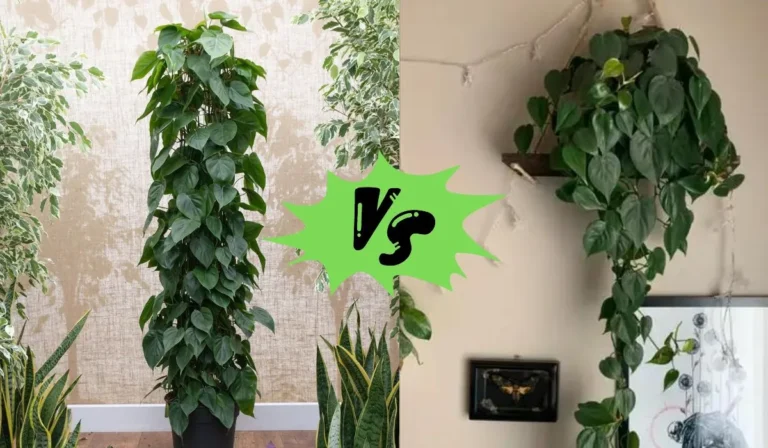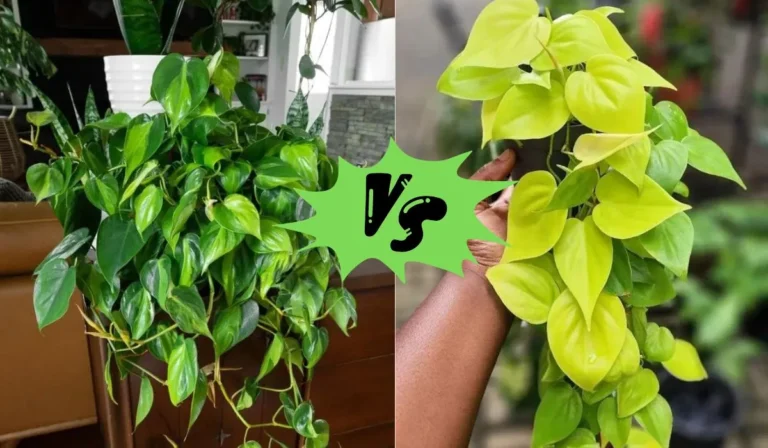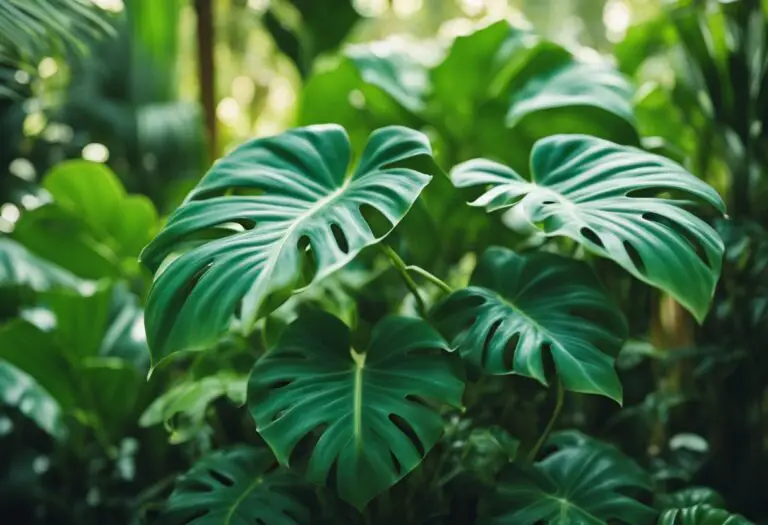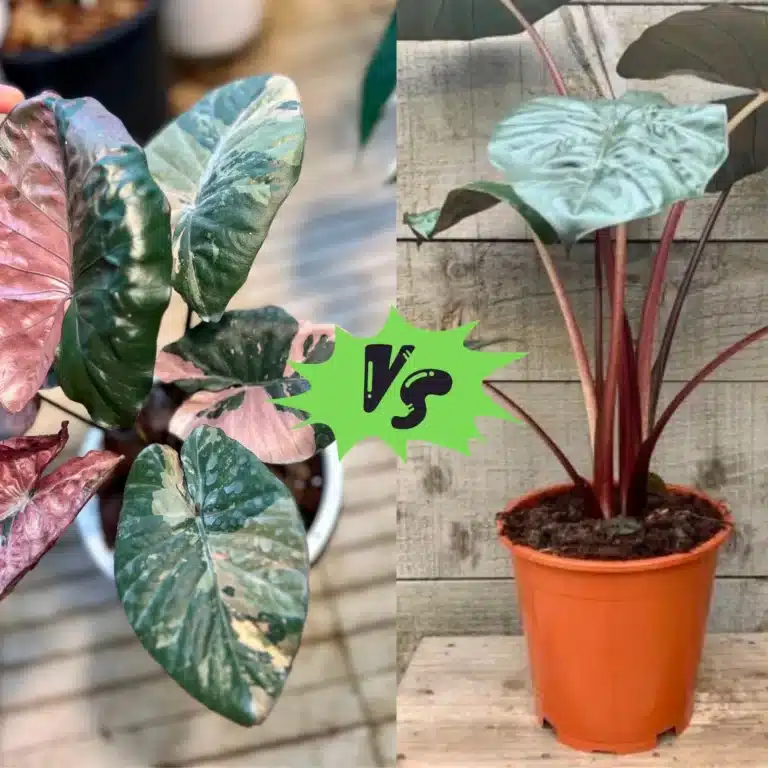Philodendron Shangri La vs Selloum: Which One is Right for You?
Philodendrons are popular choices for gardens, both indoors and outdoors, thanks to their attractive foliage and easy care. Two well-loved philodendron varieties are Shangri La and Selloum. Although they may initially appear similar, they have distinct differences that can significantly affect your garden’s overall look.
Understanding these plant characteristics can help you choose the right one for your needs. Philodendron Shangri La boasts a bushy appearance with densely-packed stems and early development of split-leaf margins.
In contrast, Philodendron Selloum grows in a tree-like pattern with spear-shaped leaves that proudly reach upward. Despite similar water, humidity, and light requirements, these differences in growth pattern and leaf shape can dramatically impact your garden’s overall aesthetic.
Key Takeaways
- Philodendron Shangri La and Selloum are two popular varieties of philodendrons with distinct differences in growth pattern and leaf shape.
- Shangri La has a bushy appearance with numerous densely-held stems and early development of split-leaf margins, while Selloum grows in a tree-like pattern with spear-like leaf shapes that grow proudly upwards.
- Understanding the differences between these two plants can help you choose the right one for your garden.

Philodendron Shangri La vs Selloum
If you’re looking to add a touch of greenery to your home or office, then Philodendrons are an excellent choice. They’re easy to care for, have attractive foliage, and are great at purifying the air.
Two popular Philodendron varieties are the Shangri La and Selloum. Let’s take a closer look at the differences between them.
Growth Pattern
The main difference between the two is their growth pattern. The Shangri La grows in a compact, bushy pattern, while the Selloum grows in a tree-like pattern.
The Shangri La has numerous stems that are densely held, giving it a very healthy and bushy look. On the other hand, the Selloum has spear-like leaf shapes that grow proudly upwards like a tree.
Appearance
The Shangri La is a hybrid, split-leaf Philodendron that was introduced in 2021 by Ball Ingenuity. It has dissected leaf margins that are more prominent at an earlier age.
The Selloum has leaves that are deeply lobed and can grow up to three feet long. The Selloum’s leaves are also thicker and more leathery than the Shangri La’s leaves.
Care
Both the Shangri La and Selloum are easy to care for and require similar conditions. They prefer bright to medium indirect light and can survive in low light, but growth will be slower.
They also prefer well-draining soil and should be watered when the top inch of soil is dry to the touch. It’s important not to overwater them as this can lead to root rot.
In my personal experience, I’ve found the Shangri La to be a great choice for smaller spaces. Its compact size and bushy growth pattern make it an excellent choice for tabletops or shelves. On the other hand, the Selloum is a great choice for larger spaces as its tree-like growth pattern can add height to a room.
Overall, both the Shangri La and Selloum are great choices for anyone looking to add some greenery to their home or office.
They’re easy to care for, have attractive foliage, and can help purify the air. Choose the one that best fits your space and enjoy the benefits of having a Philodendron in your life.
Understanding Philodendron Shangri La
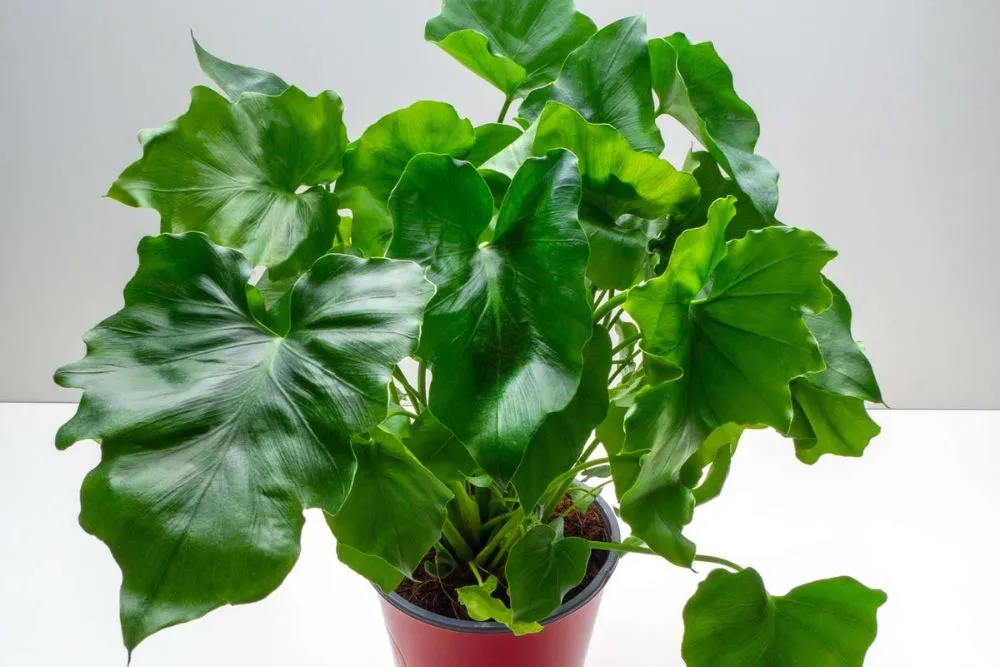
If you’re a plant enthusiast, you must have come across the Philodendron Shangri La. This beautiful indoor plant is a hybrid, split-leaf philodendron that was introduced in 2021 by Ball Ingenuity.
In this section, we will explore everything you need to know about the Philodendron Shangri La.
Origin and History
As mentioned earlier, the Philodendron Shangri La is a hybrid plant that was created by crossing two different species. It is not found growing naturally in the wild. The plant’s name is derived from the mythical place in James Hilton’s novel “Lost Horizon.”
Growth and Care
The Philodendron Shangri La is a bushy, shrub-like plant with large, deeply lobed leaves. It differs from other philodendron types by its compact size of 3 feet tall and 3 to 4 feet wide. The Shangri-La also grows in a clump from its base. Here are some tips on how to take care of your Philodendron Shangri La:
- Light: Philodendron Shangri La thrives in bright, indirect light. Avoid direct sunlight as it can scorch the leaves.
- Watering: Water the plant when the top inch of soil feels dry. Be careful not to overwater as it can cause root rot.
- Soil: Use a well-draining soil mix with peat moss, perlite, and vermiculite.
- Temperature: Philodendron Shangri La prefers temperatures between 65-80°F (18-27°C).
- Fertilizer: Use a balanced, water-soluble fertilizer every two weeks during the growing season.
Common Issues
Despite being a relatively easy plant to care for, the Philodendron Shangri La can still face some common issues. Here are some of the issues you might encounter:
- Yellowing leaves: This can be a sign of overwatering or underwatering. Make sure you’re watering your plant appropriately.
- Pests: Mealybugs and spider mites are common pests that can infest the Philodendron Shangri La. Use an insecticidal soap to get rid of them.
- Brown tips: This is usually caused by dry air. Increase humidity around the plant by misting the leaves or using a humidifier.
Exploring Philodendron Selloum
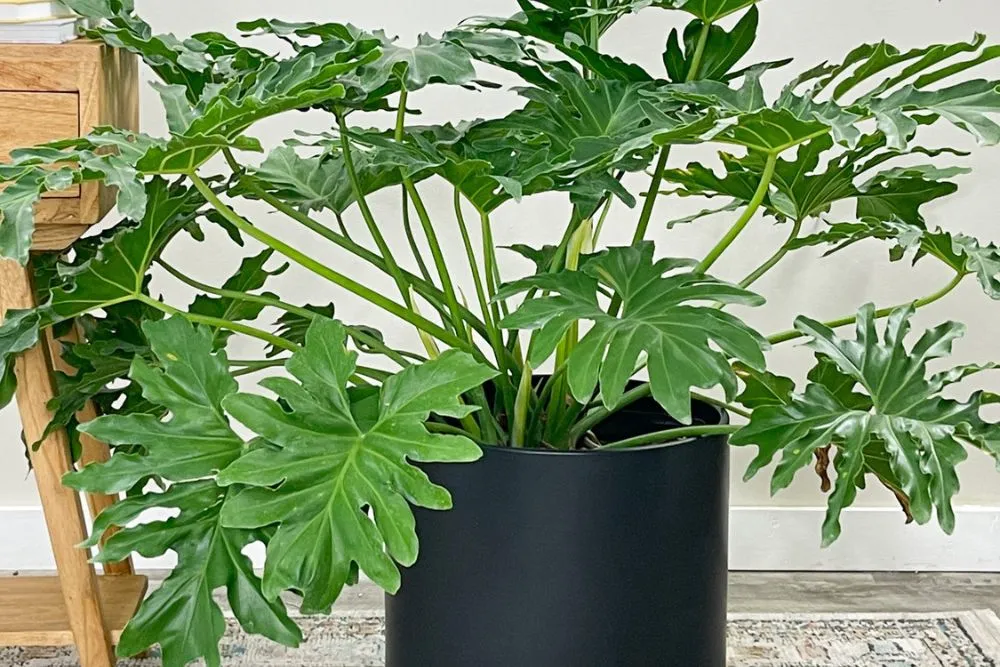
If you’re looking for a beautiful and low-maintenance plant to add to your collection, Philodendron Selloum is an excellent choice. This plant is native to South America and belongs to the Araceae family.
In this section, we will explore the origin and history of Philodendron Selloum, its growth and care requirements, and common issues you may encounter while caring for it.
Origin and History
Philodendron Selloum is also known as Thaumatophyllum bipinnatifidum. It is a non-climbing plant that thrives in its original environment and can spread up to five feet in width.
This plant is native to South America and can be found in countries such as Brazil, Bolivia, and Paraguay. It was first described by Carl Ludwig Willdenow in 1805 and was later reclassified as Thaumatophyllum bipinnatifidum in 2018.
Growth and Care
Philodendron Selloum is a relatively low-maintenance plant that can be grown both indoors and outdoors. Here are some tips on how to care for this plant:
- Light: Philodendron Selloum prefers bright, indirect light. Direct sunlight can scorch its leaves.
- Water: Water your plant when the top inch of soil feels dry to the touch. Overwatering can lead to root rot, so make sure the soil has proper drainage.
- Temperature: Philodendron Selloum prefers temperatures between 65-80°F (18-27°C).
- Soil: Use a well-draining soil mix that is rich in organic matter.
- Fertilizer: Fertilize your plant every 2-3 months during the growing season (spring and summer) with a balanced fertilizer.
Common Issues
While Philodendron Selloum is a relatively low-maintenance plant, it can still encounter some common issues. Here are some problems you may encounter while caring for this plant:
- Yellowing leaves: This can be caused by overwatering, underwatering, or too much direct sunlight.
- Root rot: This can be caused by overwatering or poor drainage.
- Pests: Philodendron Selloum can attract pests such as spider mites, mealybugs, and scale insects. Use insecticidal soap to get rid of these pests.
Overall, Philodendron Selloum is a beautiful and easy-to-care-for plant that can add a touch of tropical elegance to any space. With proper care, this plant can thrive and bring joy for years to come.
Key Differences Between Philodendron Shangri La and Selloum
If you are looking for a stunning and low-maintenance houseplant, Philodendrons are a great choice. Two popular varieties are Philodendron Shangri La and Selloum. While they share some similarities, they also have some key differences.
Here are the most significant differences between Philodendron Shangri La and Selloum:
Size and Shape of Leaves
One of the most noticeable differences between the two varieties is the size and shape of their leaves.
Philodendron Shangri La has large, deeply-lobed, heart-shaped leaves with green and silver-green splotches. On the other hand, Philodendron Selloum has much larger oblong-shaped leaves.
Growth Pattern
Another significant difference between the two varieties is their growth pattern. Philodendron Shangri La grows in a bushy pattern, while Selloum grows in a tree-like pattern.
Shangri La has numerous and densely-held stems, giving it a bushy, healthy appearance, whereas Selloum has spear-like leaf shapes that grow proudly upwards like a tree.
Size
Philodendron Shangri La is a smaller plant, growing up to 3 feet tall and 3 to 4 feet wide, making it an excellent option for smaller spaces.
In contrast, Philodendron Selloum can grow up to an impressive fifteen feet, making it a great choice for larger spaces.
Care
Both Philodendron Shangri La and Selloum are low-maintenance plants that are easy to care for. They prefer bright, indirect light and well-draining soil.
They also like to be kept moist but not waterlogged. However, Philodendron Selloum is more tolerant of lower light conditions than Shangri La.
Toxicity
It’s important to note that both Philodendron Shangri La and Selloum are toxic to pets and humans if ingested. The leaves contain calcium oxalate crystals, which can cause irritation and swelling of the mouth, tongue, and throat.
Choosing the Right Philodendron for Your Garden
When it comes to choosing between Philodendron Shangri La and Selloum, you need to consider several factors to ensure that you make the right decision for your garden. Here are some essential factors to consider:
Lighting
Both Philodendron Shangri La and Selloum require bright, indirect light to thrive. However, Shangri La can tolerate lower light levels than Selloum, making it an ideal choice for indoor gardens with less natural light.
If you plan to grow your philodendron outdoors, make sure to choose a location with partial shade to avoid scorching the leaves.
Humidity
Philodendrons thrive in high humidity environments, so it’s essential to provide them with adequate moisture to keep their foliage healthy and vibrant.
Shangri La requires higher humidity levels than Selloum, so you may need to mist the leaves regularly or use a humidifier to create the ideal growing conditions.
Maintenance Requirements
Both Philodendron Shangri La and Selloum are relatively easy to care for and require minimal maintenance. However, Shangri La is more susceptible to root rot than Selloum, so you need to ensure that the soil is well-draining and not waterlogged.
Additionally, Shangri La may require more frequent pruning to keep it in shape, while Selloum can grow to be quite large and may require a more significant amount of space.
Appearance
Philodendron Shangri La and Selloum have distinct appearances that can influence your decision. Shangri La is a compact plant that grows in a clump from its base, making it an ideal choice for smaller gardens or indoor spaces. In contrast, Selloum can grow to be quite large and has a more open and airy appearance.
Ultimately, the choice between Philodendron Shangri La and Selloum comes down to your specific needs and preferences. Both plants offer stunning foliage and are relatively easy to care for, making them an excellent choice for any indoor or outdoor garden.
Frequently Asked Questions (FAQs)
What are the distinguishing features of Philodendron Shangri La and Selloum?
Philodendron Shangri La and Selloum have some distinct features that set them apart. The Shangri La has numerous and densely-held stems, giving it a bushy, healthy appearance. It also has an early development of split-leaf margins. The Selloum, on the other hand, grows in a tree-like pattern and has a more open and airy appearance.
How do I differentiate between Philodendron Shangri La and Selloum?
To differentiate between the two, you can look at their growth patterns. Shangri La grows in a bushy pattern, while Selloum grows in a tree-like pattern. Additionally, Shangri La has split-leaf margins that develop early, while Selloum has deeply lobed leaves that develop later.
Can you tell me the differences between Philodendron Shangri La and Selloum?
The main differences between Philodendron Shangri La and Selloum are their growth patterns and leaf structures. Shangri La grows in a bushy pattern and has split-leaf margins that develop early, while Selloum grows in a tree-like pattern and has deeply lobed leaves that develop later.
Which one is better suited for indoor growing, Philodendron Shangri La or Selloum?
Both Philodendron Shangri La and Selloum are great for indoor growing, but Shangri La is better suited for smaller spaces due to its bushy growth pattern. Selloum, on the other hand, can grow quite large and may require more space. Ultimately, the choice between the two depends on your personal preference and the space you have available.
Are there any unique care requirements for Philodendron Shangri La and Selloum?
Both Philodendron Shangri La and Selloum require similar care, including water, humidity, and light requirements. However, Shangri La may require more frequent watering due to its bushy growth pattern and higher number of stems.
Can Philodendron Shangri La and Selloum be grown together in the same pot?
Yes, Philodendron Shangri La and Selloum can be grown together in the same pot. However, it is important to ensure that the pot is large enough to accommodate both plants and that they are receiving the appropriate amount of water and light.
Conclusion
In conclusion, both Philodendron Shangri La and Selloum are beautiful plants that can add a touch of greenery to your home or office. However, they do have some key differences that you should consider before making a purchase.
Firstly, the appearance of the leaves is different. Philodendron Shangri La has heart-shaped leaves with deep green and silver-green splotches, while Philodendron Selloum has oblong-shaped leaves. Both plants have large leaves that resemble elephant ears, but the shape and color of the leaves are different.
Secondly, the growth pattern of the plants is different. Philodendron Selloum is a non-climbing plant that can spread up to five feet in width. It has spear-like leaf shapes that grow proudly upwards like a tree. On the other hand, Philodendron Shangri La is a climbing plant that can grow up to six feet in height. It has a vining growth habit and can be trained to climb up a trellis or wall.
Thirdly, the care requirements of the plants are slightly different. Philodendron Selloum prefers bright, indirect light and moderate watering, while Philodendron Shangri La prefers bright, filtered light and regular watering. Both plants thrive in well-draining soil and benefit from occasional fertilization.
Finally, the price of the plants can vary depending on the size and availability. Philodendron Shangri La is usually more expensive than Philodendron Selloum due to its unique variegation and climbing growth habit.
Overall, both Philodendron Shangri La and Selloum are great choices for indoor plants. They are easy to care for, have beautiful foliage, and can add a touch of tropical elegance to any space. Consider your personal preferences and care abilities before making a purchase, and enjoy the beauty of these amazing plants!

